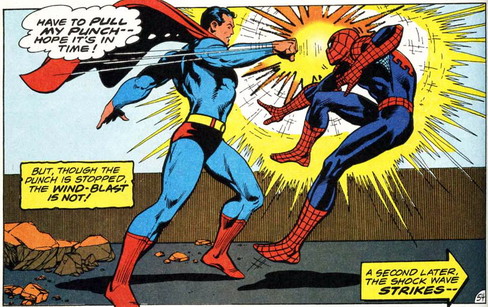Thanks to being one of the most loved and profitable entities in popular culture over the last decade, Halo has expanded way beyond the gaming space. Books, direct-to-DVD movies and toys aplenty have all spun off of Bungie’s seminal sci-fi FPS. Marvel and Microsoft have put out a bunch of Halo-centric comics over the last few years and the latest ties into the upcoming release of Halo: Reach. The Halo: Fall of Reach–Boot Camp miniseries adapts Eric Nylund’s novel, which detailed some of the inner working of the SPARTAN program. The monthly series will be appearing in comic shops next week. To find out how the project came together, I talked to the series’ writer Brian Reed, who’s also worked on Spider-Man and had a long run on Ms. Marvel and Frank O’Connor from 343 Industries–the Microsoft Games Studios division that’s the hub of all things Halo.
When do you remember first getting grabbed by the world of video games?
Brian Reed: When I was 7 years old and we got our Atari 2600, I was addicted for life!
Frank O’Connor: I’ve played video games since I was a child. The first game I played, which is going to age me here, was pong, on one of those nondescript multi-pong variant consoles. I played it at a friend’s house and I was hooked. It was magical. I used to insert my own “storylines” into anything I was playing. Pong, Combat on Atari 2600, Space Invaders, you name it. Back then I even used to make my own sound effects because the in-game ones were sort of primitive.
What are some of your strongest comics memories?
Reed: Buying Spider-Man and GI Joe off the spinner rack back when spinner racks still existed and dinosaurs roamed the Earth. I was a Marvel kid from the start when someone gave me a copy of Superman vs. Spider-Man and I wanted to see more of this Peter Parker guy.
O’Connor: My grandmother used to buy me comics when I was very young. Mostly Spider-Man, but occasionally Fantastic Four and others. In Scotland, where I grew up, Marvel comics at that time were reprinted (and re laid-out) in a horizontal landscape format. Possibly on remnant paper from some other purpose. If anything, that added something to the experience that you can’t recreate. I have to figure those are collector’s items now. I remember my first comic-nerd rage too, when a cover would promise, for example, that Namor was going to destroy Spider-Man, yet inside they would actually team up after a brief argument. I remember thinking, “Why must this Stan Lee fellow turn my childhood into a palace of lies?”
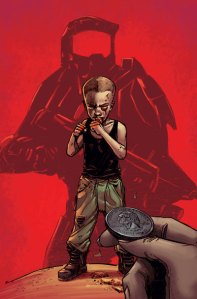
Brian, you’ve worked in game development. How would you approach a Ms. Marvel game? How would you make gameplay elements surrounding this character stand out from, say, Bayonetta?
Reed: A game always starts with what your lead character can do, and then you build around that to find interesting experiences. For Ms. Marvel, you’d want to focus on flight, feats of strength, and some ranged combat. I’d probably look at involving the Brood as bad guys so you could get into the character’s history as well as have lots of enemies to beat down. Then, for extra set dressing, I’d find ways to work in some Avengers and X-Men cameos.
In making the Boot Camp comics, you don’t have the benefit of sweeping camera pans or a soundtrack or interactive elements. Was it hard to work in the franchise’s epic scope onto the printed page?
Reed: Comics are at their most basic a very visual medium, and Halo gives you so much to play with visually that the real difficulty is figuring out how to fit in all the things you want to do.
The Fall of Reach story has already been told in prose form. Did you feel like that freed you up from some pressure or did you think fans might want a comic-book recreation of the novel?
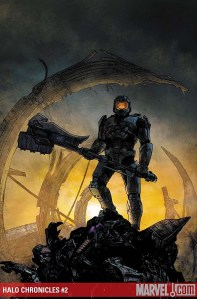 O’Connor: Our fans always want to see the written word brought to life in other forms, movies, animation, you name it. Comic books are such a satisfying storytelling method – where you not only get to enjoy the technique and character of the art, but to be surprised at how a scene you may have imagined differently, is interpreted by the artists and colorists. Sometimes, often, in fact, the surprises are better than your own imagined version.
O’Connor: Our fans always want to see the written word brought to life in other forms, movies, animation, you name it. Comic books are such a satisfying storytelling method – where you not only get to enjoy the technique and character of the art, but to be surprised at how a scene you may have imagined differently, is interpreted by the artists and colorists. Sometimes, often, in fact, the surprises are better than your own imagined version.
Reed: One of the first things that was discussed on this project was that it wasn’t going to be just a copy/paste of the novel to comic book format. I get the chance to approach scenes in a more visual manner than they need to be with prose. In a novel you can do two people talking for pages, and it’s interesting. But in comics that’s page after page of close up shots of people’s heads, and you have to be more visually inventive than that.
What scenes from the novel will you be expanding on?
Reed: Since very little is getting a 1:1 transfer over from the novel, that’s a tricky question to answer. Like film adaptations, you’ll see lots of beats you recognize, but in slightly different form. We do see some brand new stuff as well, specifically in these first few issues we expand on the character of Robert Watts, the traitor the Spartans are tasked with capturing on their first mission.
O’Connor: This will be a fairly faithful adaptation, without too many drastic variations, but the order of revelations will be adjusted to suit the format and the staging of “shots” and scenes will probably bring a few surprises with it. That said, we’re not going to deviate too far from the excellent Eric Nylund novel.
Since this is essentially Master Chief’s origin, readers will get to see what he looks like before he dons his iconic armor? What was the process for nailing his pre-SPARTAN look?
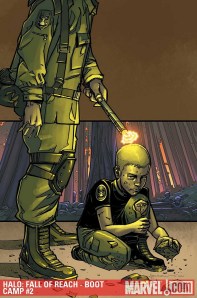 Reed: Yes, John -117’s face is exposed for a great deal of this series. The look really came from Felix Ruiz and his talks with Microsoft’s key Halo guys. The fun of John is that we first meet him as a kid, so we get to age him up over the course of the series.
Reed: Yes, John -117’s face is exposed for a great deal of this series. The look really came from Felix Ruiz and his talks with Microsoft’s key Halo guys. The fun of John is that we first meet him as a kid, so we get to age him up over the course of the series.
O’Connor: This isn’t as controversial as it sounds. Eric’s novel very deliberately describes the young MC (yes, I just said that) and the comic-book version is faithful to that description, with a lot of input from 343 which usually goes along the lines of “Tougher, braver, colder, more disciplined…” etc. But we’re working with amazing artists and writers at Marvel and they usually nail it.
Part of Master Chief’s allure has been that he’s so mysterious. How did you balance that keeping him enigmatic with trying to create some emotional connections between him and the other characters in the book?
Reed: The novel did a really good job of fleshing Master Chief out and making him more than a faceless guy. We first meet him as a boy, and we know him as John for most of the story. It’s funny how much empathy you get for someone when they stop being a rank and become a name. In the comic I’ve tried to build on what Eric Nylund laid out in the novel, and steal a few more peeks inside John’s mind as the story goes along.
O’Connor: His allure in the games is certainly enigma, in part that enigma is fueled by the genre – first-person games put you “inside” the character and seldom deviate from that perspective. In the novels, however, the Chief is a perfectly fleshed-out character with a real personality and history, relationships and a gamut of elements that are contrary to the FPS gaming experience.
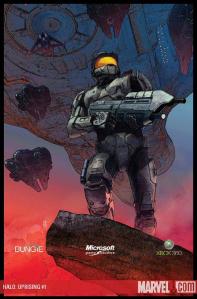 What’s your favorite moment from the Halo games?
What’s your favorite moment from the Halo games?
O’Connor: I have so many, it’s hard to pick one. But if I were forced, it would probably be the first moment after crash landing the Bumble Bee escape pod on Halo in the first game. You come out of this wreckage and look into the sky, where the silvery arc of the Halo extends above you – the effect is literally dizzying and I remember thinking, “this is just the beginning. “ And so it was.
Reed: In Halo: Combat Evolved, It’s probably a tie between the first encounter with the Flood, and the run at the end, as everything goes to hell.
Halo 2: The beat when — even though you knew it was coming — you find the second Halo. I mean, the game’s called Halo 2, there’s going to be a second Halo. But it was still just such a great “oh hell” moment for the characters that it was fun for me as well.
Halo 3: I loved the fight on Earth and the battle to get into the portal off world. The scope of that fight, with the big ships flying over the city, and all hell breaking loose — it’s beats like that you play games for.


